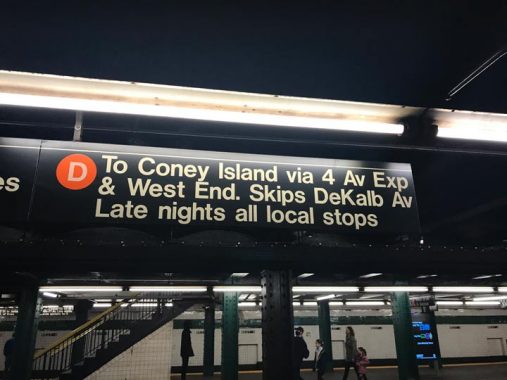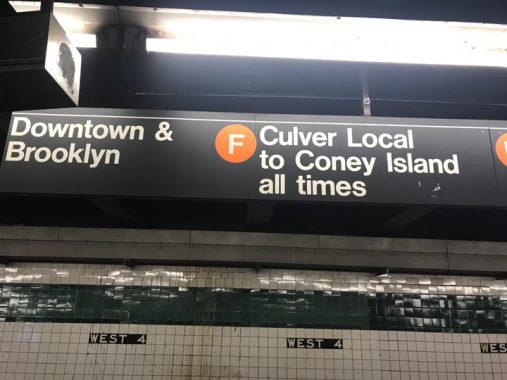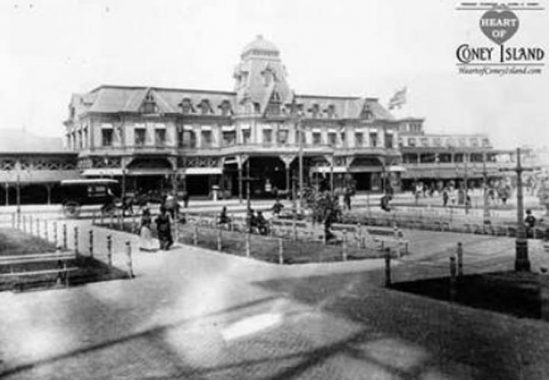
*I’m doing something a bit different this Sunday; instead of the usual longform page, I’m doing a shorter page because I was just hired part time at Marquis Who’s Who in America, and have to look at paperwork and sample writing before starting on Monday.
I was waiting for a train to Coney Island on a recent Saturday on the West 4th Street platform. Two of the available subways here go straight to Coney Island, the D and the F (during the week, B trains get as far as Brighton Beach) and the F was not running to Coney this weekend, so the D it was. I hadn’t taken the D to Coney in quite awhile; of late, to get there I’d been using the N and Q trains, which run up Broadway, while the D and F use 6th Avenue.
I noticed something about the signs. I have been a fan of the iconography of subway signs as well as street signs, they’re the “uniforms” for inanimate objects that the Metropolitan Transit Authority and NYC Department of Transportation wear. The MTA’s style, white Helvetica lettering on black signs, began with Massimo Vignelli and Bob Noorda’s Unimark, which, true to its name, “unified” subway signage under one marking system. The Unimark system has evolved over time, but is basically the same system instituted in 1968.

These signs still refer to the D as the “West End” and the F as the “Culver.” Now, these are designations for trains running in southern Brooklyn that have their own names, with the Sea Beach (N) and Brighton (B, Q) joining the party. Frankly, I can’t imagine any subway rider younger than 50, other than railbuffs, who uses these names other than the letters. Does anyone still say, “I’m getting the West End to Coney Island” instead of “I’m taking the D to Coney Island”?
Even more amazingly, these names originated in the 1880s, when steam railroads plied the routes that the current trains, on tracks now electrified with third rails and mounted on elevated structures and embankments.
The West End
in 1863, a steam railroad built by Charles Godfrey Gunther, a former NYC mayor, was built from the entrance to Green-Wood Cemetery to Bath Beach. The line necessitated a transfer at 36th Street (just as today’s subways do from the D to the N and R) because steam railroads were forbidden in Brooklyn in that era. A horsecar line completed the run from 5th and 36th to 5th and 25th. The steam line was completed out to Coney Island in 1864, where it met the West End Hotel. After an 1885 reorganization the line became the Brooklyn, Bath and West End Railroad, was electrified by overhead catenary wire in 1893, was acquired by Brooklyn Rapid Transit in 1898, and finally, was replaced by the West End Elevated in November 1916. Unfortunately, Gunther’s name never attached itself to subsequent iterations of his railroad the way Andrew Culver’s did to what is now the F train in Brooklyn.
Charles Gunther’s Railroad [thirdrail.net ]
New Utrecht Avenue, Naked [FNY]

The Sea Beach
The New York and Sea Beach Railroad ran from a ferry landing in Bay Ridge to the Sea Beach Palace Hotel in Coney Island beginning in 1876, the country’s centennial. At first, it was a steam railroad running through open country, through an occasional small settlement or town. Brooklyn became slowly urbanified in the late 19th Century and a street grid appeared, with the railroad then running in a right of way between 63rd and 64th Streets as far as 21st Avenue, when it turned south and ran between West 7th and 8th Streets. In 1915, the route was electrified and placed in an open cut; since the 1960s, it’s been the N train, but it’s never lost its former “Sea Beach” designation.
The Brighton Line
In 1877, the Brooklyn, Flatbush and Coney Island Railway was incorporated, opening the next year in 1878. It originally ran from the Prospect Park entrance at Flatbush and Ocean Avenues south to the Brighton Beach Hotel, built near the water’s edge.
After 1882, when the Long Island Rail Road took over a BF&CI competitor, the New York and Manhattan Beach Railroad, it found itself competing with itself for suburban railroad customers. The NY&MB had been created by LIRR chief Austin Corbin before that railroading giant assumed control of the LIRR, and accordingly, the LIRR evicted the BF&CI from its trackage at the end of 1883 after just six years in service. BF&CI service was truncated to the Bedford Terminal at Frankin and Atlantic Avenues, where there was a turntable for turning the steam engines.
No longer having a desirable northern terminal, the BF&CI was forced into bankruptcy and was reorganized in 1887 as the Brooklyn and Brighton Beach Railroad. The next year the Brighton Beach Hotel was moved inland–by railroad–to keep it from slipping into the sea. In 1896, the problem of what to do with the northern end of the line was solved when a ramp was built to connect new Kings County Elevated that ran along Fulton Street to the Brooklyn & Brighton Beach from a junction at Franklin and Fulton, bridging Atlantic Avenue and connecting to the Brighton several blocks south of that point.
Over time, the steam railroad was both electrified and truncated, becoming today’s Brighton Line (B,Q) running to Coney Island and the portion from Prospect Park to the Fulton El is still run as a two-car shuttle. Over the decades the MTA neglected the shuttle until it became dangerously decrepit, but it was virtually rebuilt at the end of the 1990s. Today it transfers to the local Franklin Avenue stop on the C train under Fulton Street.

Transit buffs recall the Culver Shuttle, which ran between 1954 and 1975 and was itself a remnant of the old Culver Line, which was preceded by a steam railroad line, the Prospect Park and Coney Island, which beginning in 1875 ran between 9th Avenue and 20th Street to the present Shell Road and Avenue X.

The line was built by railroad entrepreneur Andrew N. Culver, an early player in railroad development in southern Brooklyn, and he also branched into hotel development. Culver, with the aid of enterpreneur Thomas Cable, built Culver Plaza North at today’s Surf Avenue and West 5th Street, to house and cater to wealthy seaside visitors.
Cable’s Hotel opened for business well before the railroad did. Only men were permitted to stay at the hotel, but women and children were welcome to dine in its restaurant. Cable seemed to have in mind an English style gentlemen’s club, in which they could drink their whiskies and soda, smoke their cigars, read their newspapers, and discuss business, politics, sports, and show girls. Cable was also said to have had the best wine cellar in Coney Island. [Heart of Coney Island]
Years after the seaside hotels of Coney have been razed; decades after the Culver steam railroad stopped running and was replaced by an elevated train — Andrew Culver is still remembered on station signage, as well as route markings on the R-46 trains that ply the F train.
Thus, when you look at a modern subway sign in any given station, you may be looking at nomenclature that stretches back nearly 150 years.
For the complete story of southern Brooklyn’s railroads, see Brian Cudahy’s How We Got to Coney Island.
Check out the ForgottenBook, take a look at the gift shop, and as always, “comment…as you see fit.” I earn a small payment when you click on any ad on the site.
4/11/21


13 comments
I grew up next to the Culver, and I wonder how many businesses are left with “Culver” in their names. There were a lot back then.
Good luck with the new job.
Congrats on the new gig! I hope it will leave you enough time to keep teaching us the history of your beautiful city!
I seem to recall Bill Lynch, deputy mayor under Dinkins lobbied very hard to retain those names. It seemed at the time to be his personal need for the nostalgia, but got the MTA to cave.
I barely know anyone who knows the difference between the BMT and IRT, let alone the various line names. About 10 years ago, I was helping some of my younger friends move to an apartment in Morningside Heights when a lovely old woman dressed in her Sunday best, church hat and all, asked my 20-something friend how to get to the IRT. He yelled upstairs to me in a panic “hey Eddie, this lady is looking for the IRT…where is that?!” I dutily came downstairs and asked her if she was looking for the Broadway IRT line, and she was very relieved that I was able to point her in the right direction. I doubt very few “new” New Yorkers would be able to answer her question today.
I Wish you all the best luck on your 1st day with the new job. You are starting on my birthday so I know you will do great. Enjoy
Good luck with you new gig. Hope it works out and lasts for a long time.
The four Coney Island routes are unique because, as you point out, their names go back to the 19th century steam railroads and Brooklyn’s pre-5 borough history. It’s fascinating to me that Coney Island started out as a fancy hotel resort, not a day trip destination for the masses. It’s even better than the four route names persist to this day despite the rather ordinary letter designations they use. Certainly, “West End” and “Brighton” sound better than D and Q, respectively.
The subway routes in Manhattan, The Bronx, and Queens, don’t have this kind of lineage, with two exceptions. The A train to/from the Rockaways is similar to the Coney Island routes; it was a LIRR route until 1955. The #5 Dyre Avenue Line in The Bronx was originally a railroad as well, but it started later (1912) and was not built originally as a summer resort route. The railroad was shut down in 1937 and the route became a NYC subway branch in 1941.
When the conductor announces the next station over the P.A. system
does he still sound like Moms Mabley?Could rarely understand him.
I am 56, grew up in Astoria and never really knew the difference between BMT and IRT. My subway line was the RR, then it became the N about 30ish years ago.
Your article hits upon the distinction between route names and service designations, a principle that applies not only to subway service but also to bus service. A route name refers to the infrastructure upon which public transportation operates; a service designation refers to the path, or the collection of routes, over which vehicles regularly traverse. The two terms are clearly related but quite distinct from one another. Generally, routes, and their names, remain the same over time, while various services, and their designations, may change over time. So, for example, many years ago the “D” train service operated over the Brighton Beach route, while today the “D” train service operates over the West End route.
Because of the greater stability of route names, compared to the relative ease of changing the paths over which various services may operate, it is more descriptive and understandable in many cases to make reference to a route name than to a service designation. So when standing on the platform at West Fourth Street, the use of route names to describe the paths of the “B,” “D,” and “F” train services adds valuable information as the paths to be taken by these trains destined for Coney Island. Because individual service designations change over time, and both scheduled construction projects and unplanned incidents frequently require specific services to be diverted to alternative routes, the use of service designations to describe the paths taken is inadequate. The route names—those mentioned in this article and many others—remain viable and important descriptions.
Congratulations on the new job Kev!
The B train terminates at Brighton Beach, not West 8th street.
all right.